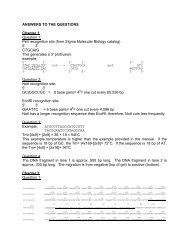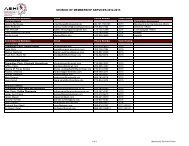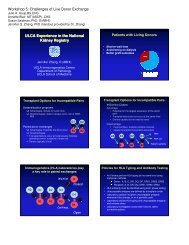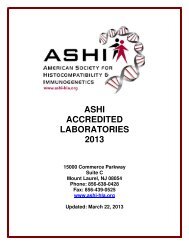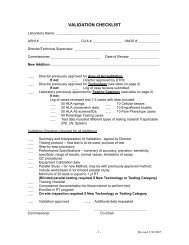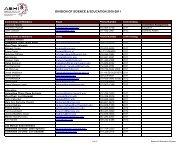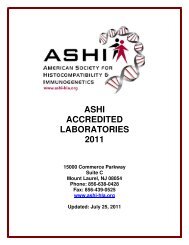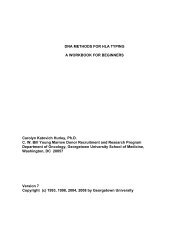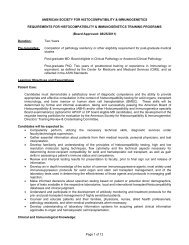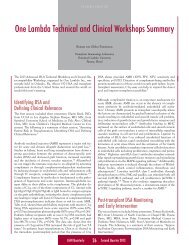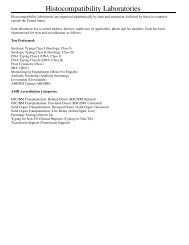Conclusions: These results demonstrate that, despite markedly improved sensitivity, the use of solid phasemethods to identify HLA-specific antibodies may provide apparently aberrant results that require carefulclinical and laboratory investigation.53-PTHE IMPACT OF ALLOSENSITIZATION ON TIME TO TRANSPLANTATION ANDMORTALITY IN A COHORT OF PATIENTS AWAITING LUNG TRANSPLANTATION.Joseph T. Weber 1 , Bryan F. Meyers 2 , Alexander Patterson 2 , Elbert P. Trulock 1 , ThalachallourMohanakumar 3 , Ramsey Hachem 1 . 1 Division of Pulmonary & Critical Care Medicine, WashingtonUniversity School of Medicine, Saint Louis, MO, USA; 2 Division of Cardiothoracic Surgery, WashingtonUniversity School of Medicine, Saint Louis, MO, USA; 3 Department of Surgery, Washington UniversitySchool of Medicine, Saint Louis, MO, USA.Aim: To determine if allosensitization has an impact on the rate of transplantation, waiting time, or wait listmortality in those awaiting lung transplantation.Methods: We per<strong>for</strong>med a retrospective cohort study of 64 consecutive candidates who were active on thewaiting list at our program between 01/2<strong>00</strong>6 and 07/2<strong>00</strong>7. Patients were prospectively screened <strong>for</strong>pre<strong>for</strong>med anti-HLA antibodies using the LABScreen Single Antigen assay at the time of listing. Acalculated Panel Reactive Antibody (cPRA) was obtained using the UNOS calculator <strong>for</strong> each candidate.We analyzed time to event using the Kaplan-Meier and Cox regression methods.Results: Of the 64 candidates, 22 (34%) were sensitized and 17 (26%) had a cPRA>50%. Sensitizedcandidates were significantly less likely to undergo transplantation using the virtual crossmatch approach(log rank p=0.<strong>00</strong>06).[figure1]In a multivariate Cox regression analysis, cPRA>50% was a significantnegative predictor of transplantation (OR=0.28; 95%CI: 0.1-0.6, p=0.<strong>00</strong>1). Additionally, 4 of the 42 (10%)non-sensitized patients died while on the waiting list compared to 5 of the 22 (23%) sensitized patients (p =0.<strong>00</strong>4). All 5 sensitized patients who died on the waiting list had a cPRA>50% while none of the sensitizedpatients with a cPRA
Conclusions: The XM-One assay can be used to detect donor specific anti-endothelial antibodies in asimple flow-cytometric cross match assay. The endothelial antigen system seems to be polymorphic. Theclinical significance of this assay is still under investigation.55-PDONOR SPECIFIC ANTIBODIES (DSA) – COMPLEMENT BINDING OR NOT? THE IMPACTON KIDNEY REGRAFT OUTCOMES.Isabelle G. Wood, Nabil Mohsin, Indira Guleria, Helen H. Mah, Edgar L. Mil<strong>for</strong>d. Tissue TypingLaboratory, Brigham and Women’s Hospital, Boston, MA, USA.Aim: Our goal was to evaluate the impact of DSA not detected by cytotoxic crossmatches (CDC) on graftoutcome in retransplant kidney recipients. Do flow cytometry crossmatches with T and B cells(TFXM,BFXM), solid phase Single Antigen (SA) screening (One Lambda), and SA modified to identifycomplement (C’) binding results predict graft outcome?Methods: We analyzed outcome in 103 kidney recipients from 14 centers in New England who had faileda prior transplant. At the time of transplant, the T cell cytotoxic screening and CDC T cell crossmatch withanti-globulin were the only immunologic exclusionary criteria. To determine the impact of DSA notdetected by CDC we tested pretransplant sera by TFXM, BFXM and SA <strong>for</strong> Class I and II anti-HLAantibodies. In addition, a modified SA technique (C’SA) was per<strong>for</strong>med using a complement sourcefollowed by mouse anti-C4d and anti-mouse phycoerythrin.Results: The table shows % 1 year graft survival in regraft patients. PEL= those with early loss of a priorgraft. C’DSA data includes only patients with positive DSA.[table1]Conclusions: Previous early graft loss, T or BFXM+, DSA I+, DSA II+ and C’DSA I+ were risk factors<strong>for</strong> graft loss. PEL patients clearly benefit from SA and FXM testing. Complement binding antibodiesdetected with C’SA need further study in a larger population of primary and regraft patients to ascertaintheir significance.56-PFACTORS AFFECTING THE RELATIONSHIP BETWEEN SINGLE ANTIGEN ANTIBODYASSAYS AND CROSSMATCH RESULTS.Danny Youngs, Paul Warner, Karen Nelson. Immunogenetics Laboratory, Puget Sound Blood Center,Seattle, WA, USA.Aim: Prediction of crossmatch (XM) results from single antigen bead assays is imperfect. Two variablesthat might contribute to the problem were evaluated. Experiments were run to determine the effect bead-tobeadcompetition <strong>for</strong> antibodies had on single antigen MFIs, and the effect multiple target antigens on cellshad on XM strength.Methods: LABScreen Single Antigen Combi (LSAC) and LABScreen Single Antigen Singles (LSAS)(One Lambda, Inc.) were tested against mouse anti-HLA monoclonal antibodies (monoclonals werespecific <strong>for</strong> one, a few, many or all class I HLA beads). Monoclonal antibodies were used to ensure that theantibodies were single specificities, and diluted so that each gave an MFI of approximately 4<strong>00</strong>0 against A2or A3 LSAS bead. Sera with known antibodies were flow crossmatched against cells bearing one, two,three or four antigens that were the targets of the antibodies.Results: For the LSAC assay, as the number of target beads <strong>for</strong> the monoclonals increased, the MFIsdecreased substantially, roughly 2-3% <strong>for</strong> each additional target bead (<strong>for</strong> Bw4, with 24 target beads, aroughly 50% decrease in MFI is predicted). In the XMs, as the number of antibody targets increased, theflow XM shifts increased.Conclusions: Competition <strong>for</strong> antibodies in the LSAC assay can cause significant reductions in MFIs whentarget epitopes are shared by antigens on many different beads. In contrast, multiple antigen targets on XMcells have the opposite affect: shifts increase with increasing numbers of targets. These differing dynamicscan significantly impact the relationship between an MFI level in an LSAC assay and the strength of a flowcytometry XM. The competitive effect in the LSAC assay and the additive effect in the MX make therelationship between the two tests highly variable, and adversely affect the ability to successfully predictflow XM results from single antigen test results.
- Page 1 and 2: Monday, September 27, 20102:00 PM -
- Page 3 and 4: 5-ORTWO CASES OF DONOR SPECIFIC ANT
- Page 5 and 6: Monday, September 27, 20102:00 PM -
- Page 7 and 8: Results: PHA-induced mRNA expressio
- Page 9 and 10: conjugated IgM (BD Biosciences), Ig
- Page 11 and 12: Methods: Peripheral blood and endom
- Page 13 and 14: Aim: NK cells have an established r
- Page 15 and 16: Methods: Sera (n=22) were tested fo
- Page 17 and 18: expression on lymphocytes, we hypot
- Page 19 and 20: Conclusions: Clean SA beads can eli
- Page 21 and 22: goal is to re-examine our previous
- Page 23 and 24: Aim: There is increasing evidence t
- Page 25 and 26: esult in poor graft survival. The g
- Page 27 and 28: Aim: Pronase treatment eliminates i
- Page 29 and 30: 34-PCLINICAL AND PATHOLOGICAL SIGNI
- Page 31 and 32: Nabil Mohsin, Isabelle G. Wood, Ind
- Page 33 and 34: donor/recipient pairs for transplan
- Page 35 and 36: and tested in the DynaChip assay fo
- Page 37: average difference between Ave and
- Page 41 and 42: 59-PCYTOTOXIC AND NON-CYTOTOXIC ANT
- Page 43 and 44: data suggests that DTT pretreatment
- Page 45 and 46: Bhavna Lavingia 1 , Chantale Lacell
- Page 47 and 48: ATG INTERFERNCE IN SINGLE ANTIGEN L
- Page 49 and 50: 75-PPREFORMED LOW REACTIVE ANTI-HLA
- Page 51 and 52: Sabarinathan Ramachandran 1 , Naohi
- Page 53 and 54: 83-PALLELIC DIVERSITY OF KIR2DL4 AN
- Page 55 and 56: São Paulo, Brazil; 3 Commissariat
- Page 57 and 58: 91-PCHARACTERIZATION OF COMMON AND
- Page 59 and 60: Conclusions: The extensive diversit
- Page 61 and 62: 99-PPOTENTIAL COMMON NOVEL ALLELES
- Page 63 and 64: 103-PTOWARDS A FUNCTIONAL HLA-DPB1
- Page 65 and 66: 107-PWHOLE GENOME AMPLIFICATION (WG
- Page 67 and 68: 111-PLOSS OF MISMATCHED HLA IN FAMI
- Page 69 and 70: 115-PDONOR EPITHELIAL CELL CHIMERIS
- Page 71 and 72: Caucasian patients. MRs vary signif
- Page 73 and 74: Results: We obtained the total No.
- Page 75 and 76: cord blood and platelet transfusion
- Page 77 and 78: 131-PASSOCIATION OF IL-2-330(G/T) W
- Page 79 and 80: Institute, Children’s Hospital Oa
- Page 81 and 82: Methods: To prove the robustness of
- Page 83 and 84: populations.We studied the involvem
- Page 85 and 86: amplicons generated from different
- Page 87 and 88: Results: The sequence of the unexpe
- Page 89 and 90:
concentration of the Taq Polymerase
- Page 91 and 92:
160-PASSOCIATION OF HAPLOTYPES WITH
- Page 93 and 94:
164-PDETECTION OF A DE NOVO DONOR S
- Page 95 and 96:
168-PA NOVEL HLA-DQB1 ALLELE CONFIR
- Page 97 and 98:
172-PSCREENING FOR HLA-SPECIFIC ALL
- Page 99 and 100:
176-PIMPLEMENTATION OF THE WORLD HE
- Page 101 and 102:
epertoire of displayed ligands and
- Page 103 and 104:
mucosa. No other samples were avail
- Page 105 and 106:
Conclusions: In previously reported
- Page 107 and 108:
Conclusions: Our findings can demon
- Page 109 and 110:
Conclusions: In analyzing this data
- Page 111 and 112:
examined on microarrays from a huma
- Page 113 and 114:
Methods: Serial analysis of sera ob
- Page 115 and 116:
Conclusions: These new technologies
- Page 117 and 118:
allograft injury. Four of these 18
- Page 119 and 120:
A NOVEL HLA CLASS I SINGLE ANTIGEN
- Page 121 and 122:
Results: Approximately twice as man
- Page 123:
Methods: Molecular HLA typing was p



